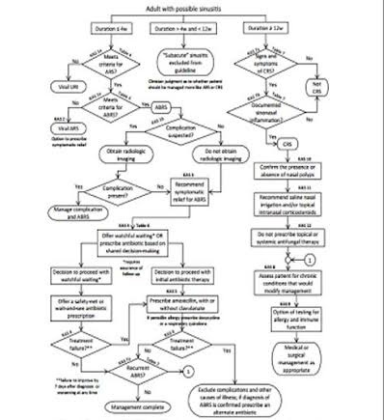- Home
- Editorial
- News
- Practice Guidelines
- Anesthesiology Guidelines
- Cancer Guidelines
- Cardiac Sciences Guidelines
- Critical Care Guidelines
- Dentistry Guidelines
- Dermatology Guidelines
- Diabetes and Endo Guidelines
- Diagnostics Guidelines
- ENT Guidelines
- Featured Practice Guidelines
- Gastroenterology Guidelines
- Geriatrics Guidelines
- Medicine Guidelines
- Nephrology Guidelines
- Neurosciences Guidelines
- Obs and Gynae Guidelines
- Ophthalmology Guidelines
- Orthopaedics Guidelines
- Paediatrics Guidelines
- Psychiatry Guidelines
- Pulmonology Guidelines
- Radiology Guidelines
- Surgery Guidelines
- Urology Guidelines
Clinical Practice Guidelines: Adult Sinusitis
Sinusitis or and its corresponding headache is one of the most common presentations seen by a family physician. Simply put, Sinusitis or Rhinosinusitis is defined as symptomatic inflammation of the paranasal sinuses and nasal cavity.
Rhinosinusitis may be classified by duration as acute rhinosinusitis (ARS) if less than 4 weeks' duration or as chronic rhinosinusitis (CRS) if lasting more than 12 weeks, with or without acute exacerbations. ARS may be classified further by presumed etiology, based on symptoms and time course, into acute bacterial rhinosinusitis (ABRS) or viral rhinosinusitis (VRS). Distinguishing pre- sumed bacterial vs viral infection is important because antibi- otic therapy is inappropriate for the latter. When patients have 4 or more annual episodes of rhinosinusitis, without persistent symptoms in between, the condition is termed recurrent ARS.
In 2015,American Academy of Otolaryngology—Head and Neck Surgery Foundation came out with the guidelines on Adult Sinusitis. This guidelines acts as an update on the 2007 guidelines on the same topic.
The major recommendations of this guidelines are as follows:-
- DIFFERENTIAL DIAGNOSIS OF ACUTE RHINOSINUSITIS: Clinicians should distinguish presumed acute bacterial rhinosinusitis (ABRS) from acute rhinosinusitis caused by viral upper respiratory infections and noninfectious conditions. A clinician should diagnose ABRS when (a) symptoms or signs of acute rhinosinusitis (purulent nasal drainage accompanied by nasal obstruction, facial pain-pressure-fullness, or both) persist without evidence of improvement for at least 10 days beyond the onset of upper respiratory symptoms, or (b) symptoms or signs of acute rhinosinusitis worsen within 10 days after an initial improvement (double worsening).
- RADIOGRAPHIC IMAGING AND ACUTE RHINOSINUSITIS: Clinicians should not obtain radiographic imaging for patients who meet diagnostic criteria for acute rhinosinusitis, unless a complication or alternative diagnosis is suspected.
- SYMPTOMATIC RELIEF OF VIRAL RHINOSINUSITIS (VRS): Clinicians may recommend analgesics, topical intranasal steroids, and/or nasal saline irrigation for symptomatic relief of VRS.
- SYMPTOMATIC RELIEF OF ACUTE BACTERIAL RHINOSINUSITIS (ABRS): Clinicians may recommend analgesics, topical intranasal steroids, and/or nasal saline irrigation for symptomatic relief of ABRS.
- INITIAL MANAGEMENT OF ACUTE BACTERIAL RHINOSINUSITIS (ABRS): Clinicians should either offer watchful waiting (without antibiotics) or prescribe initial antibiotic therapy for adults with uncomplicated ABRS. Watchful waiting should be offered only when there is assurance of follow-up, such that antibiotic therapy is started if the patient's condition fails to improve by 7 days after ABRS diagnosis or if it worsens at any time.
- CHOICE OF ANTIBIOTIC FOR ACUTE BACTERIAL RHINOSINUSITIS (ABRS): If a decision is made to treat ABRS with an antibiotic agent, the clinician should prescribe amoxicillin with or without clavulanate as first-line therapy for 5 to 10 days for most adults.
- Treatment failure FOR ACUTE BACTERIAL RHINOSINUSITIS (ABRS): If the patient fails to improve with the initial management option by 7 days after diagnosis or worsens during the initial management, the clinician should reassess the patient to confirm ABRS, exclude other causes of illness, and detect complications. If ABRS is confirmed in the patient initially managed with observation, the clinician should begin antibiotic therapy. If the patient was initially managed with an antibiotic, the clinician should change the antibiotic.
- Diagnosis of CHRONIC RHINOSINUSITIS (CRS) OR ACUTE RHINOSINUSITIS (ARS): Clinicians should distinguish CRS and recurrent ARS from isolated episodes of acute bacterial rhinosinusitis and other causes of sinonasal symptoms.
- Modifying factors: Clinicians should assess the patient with chronic rhinosinusitis or recurrent acute rhinosinusitis for multiple chronic conditions that would modify management such as asthma, cystic fibrosis, immunocompromised state, and ciliary dyskinesia.
- OBJECTIVE CONFIRMATION OF A DIAGNOSIS OF CHRONIC RHINOSINUSITIS (CRS): The clinician should confirm a clinical diagnosis of CRS with objective documentation of sinonasal inflammation, which may be accomplished using anterior rhinoscopy, nasal endoscopy, or computed tomography.
- CHRONIC RHINOSINUSITIS (CRS) WITH POLYPS: The clinician should confirm the presence or absence of nasal polyps in a patient with CRS.
- TESTING FOR ALLERGY AND IMMUNE FUNCTION: The clinician may obtain testing for allergy and immune function in evaluating a patient with chronic rhinosinusitis or recurrent acute rhinosinusitis.
- CHRONIC RHINOSINUSITIS (CRS) WITH POLYPS: The clinician should confirm the presence or absence of nasal polyps in a patient with CRS.
- TOPICAL INTRANASAL THERAPY FOR CHRONIC RHINOSINUSITIS (CRS): Clinicians should recommend saline nasal irrigation, topical intranasal corticosteroids, or both for symptom relief of CRS.
- ANTIFUNGAL THERAPY FOR CHRONIC RHINOSINUSITIS (CRS). Clinicians should not prescribe topical or systemic antifungal therapy for patients with CRS.
Following is the Algorithm showing the interrelationship of guideline key action statements. ABRS, acute bacterial rhinosinusitis; ARS, acute rhinosinusitis; CRS, chronic rhinosinusitis; KAS, key action statement; URI, upper respiratory infection.
 Image source: Head and Neck Surgery April 2015 152: S1-S39, doi:10.1177/0194599815572097
Image source: Head and Neck Surgery April 2015 152: S1-S39, doi:10.1177/0194599815572097
Disclaimer: This site is primarily intended for healthcare professionals. Any content/information on this website does not replace the advice of medical and/or health professionals and should not be construed as medical/diagnostic advice/endorsement or prescription. Use of this site is subject to our terms of use, privacy policy, advertisement policy. © 2020 Minerva Medical Treatment Pvt Ltd